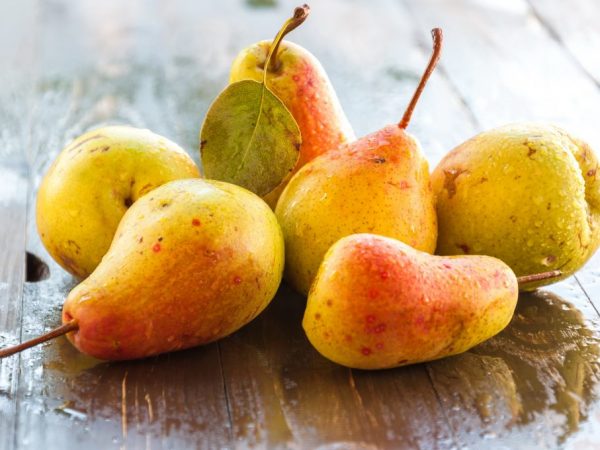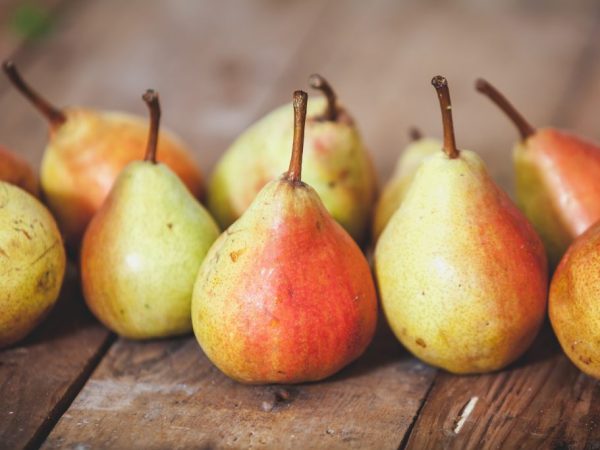Description of the Akademicheskaya pear variety
To obtain a high and high-quality pear harvest, it is important to choose the right variety. Many gardeners prefer frost-resistant and autumn species. Pear Akademicheskaya is endowed with all positive properties and gives excellent results when harvesting.

Description of the Akademicheskaya pear variety
Variety characteristic
According to the description, the Akademicheskaya pear variety is early autumn. It was bred thanks to the Moscow Agronomists Academy. K. A. Timiryazeva. The origin of the plant has not been established. In 1997, he was sent to the State test in the Central regions.
The pear is medium in size. It reaches a height of 2-3 m. The beginning of fruiting begins at 3-4 years of age. Ripens in September.
Up to 50 kg of fruit can be harvested from a tree. The plant is self-fertile, so pollination is not required. However, if the gardener wants to increase the yield, cross-pollination with several hybrids planted side by side is recommended.
Features of the fetus
The pear color is yellow. The fruit weighs 130-250 g. After formation, they do not deteriorate, so they can stay on the tree for a long time.
The ripened fruits can be consumed both fresh and canned for the winter. The pulp is juicy, firm, white.
Landing rules
If you plant a pear of the Akademicheskaya variety in accordance with all the rules, then it will thank you with a rich harvest. It is important to choose high quality planting material.
- You only need to buy seedlings in a nursery or garden store.
- The plant is 2 years old. The height of the trunk should be at least 1.5 m, and the diameter 1.5-1.8 cm. The buds are closed, the bark without various damages.
- It is best to buy seedlings in the spring.
- The plant must have at least 5 developed main roots, 30 cm in size.
- It is worth carefully considering the root system so that there is no damage, rot and mold, and the soil is moist.
Disembarkation dates
Planting is carried out with the arrival of spring, until the buds begin to bloom. It is better for the plant to get used to the ground during the period of sap flow, therefore, it is not recommended to plant a pear in the fall. In the southern regions, planting can be carried out in September.
Seat selection
This plant variety is picky. He loves a lot of light and warmth. A site with a good level of illumination is chosen for landing, because lack of light can adversely affect the amount of the crop. With the help of sunlight, Akademicheskaya pear stores sugar.
Composition of the earth
The pear of the Akademicheskaya variety is whimsical to the structure of the soil. The acidity should be in the range of 5-6. It is important that the soil is loose, light and fertile. The best option is considered - sandy loam-chernozem soil, light loam. Clay soil is not suitable: even with the introduction of special fertilizers, the Academic species will not grow.
Landing
Description of planting seedlings:
- preparation of a pit, 60-80 cm wide, 1 m deep;
- the distance between plants is not less than 2.5-3 m;
- soil consists of earth and humus, preferably horse (2-3 buckets), add 1 glass of superphosphate and 3 tbsp. l. potassium sulfate;
- if the ground is not loose, you need to additionally add 2 buckets of sand and 1 glass of slaked lime;
- a drainage made of broken bricks, 20 cm high, is placed in the pit, a reliable support is placed next to the plant;
- part of the substrate is poured into the hole so that the roots are slightly higher than the ground by 4-7 cm;
- carefully spread the roots, fill up the rest of the earth and compact;
- at the end, it is important to form a near-trunk circle, pour water into it and mulch it with peat.
Plant care rules

With proper care, there will be good results.
The care is as follows:
- clearing the site from weeds;
- soil mulching;
- making dressings;
- watering;
- pruning.
Top dressing
In the first year of the growing season, the plant does not need feeding, there are enough of those substances that were introduced during planting. Organics should be added every 2-3 years. For this, humus, humus and ash are used.
Top dressing in the form of minerals is applied every year in spring and autumn. To do this, apply (per 1 m2):
- 10 g of urea;
- 50 g superphosphate;
- 25 g of potassium sulfate;
- 20 g of saltpeter;
- 30-40 g of calcium;
- 15 g of potassium chloride.
Watering
According to the description, the culture is drought-resistant. During the period of budding and fruit formation, it is necessary to water. An adult plant needs 2 buckets of water 4-5 times a month. Water in the morning and late in the evening for 10 liters. At the time of laying the buds, the number of waterings is increased. With the onset of autumn, they are completely stopped.
Pruning
Pruning a tree is a necessary procedure. With it, you can control the yield. The procedure is carried out in the spring. Weak, damaged and frozen branches are cut off, the lower branches are removed, which lie on the ground under the weight of the fruit.
Cutting the crown is necessary to protect the plant from pests, as well as to increase the yield. When pruning, you must not remove more than a quarter of the branches.
A young seedling is pruned immediately after planting. Remove 3 parts of each branch. 1 year old buds must be removed completely.
Diseases and pests
The plant has strong immunity to black crayfish and scab. Practically not exposed to common pear diseases and pests.
In order to avoid the appearance of ailments, it is necessary to carry out drip irrigation, the purpose of which will be to wash away unwanted bacteria and larvae from the leaves.
Conclusion
Pear Akademicheskaya is a winter-hardy variety. With proper cultivation, you can get a rich and high-quality harvest. Many gardeners choose this particular type of fruit tree for planting, because its fruits are juicy and sweet.


